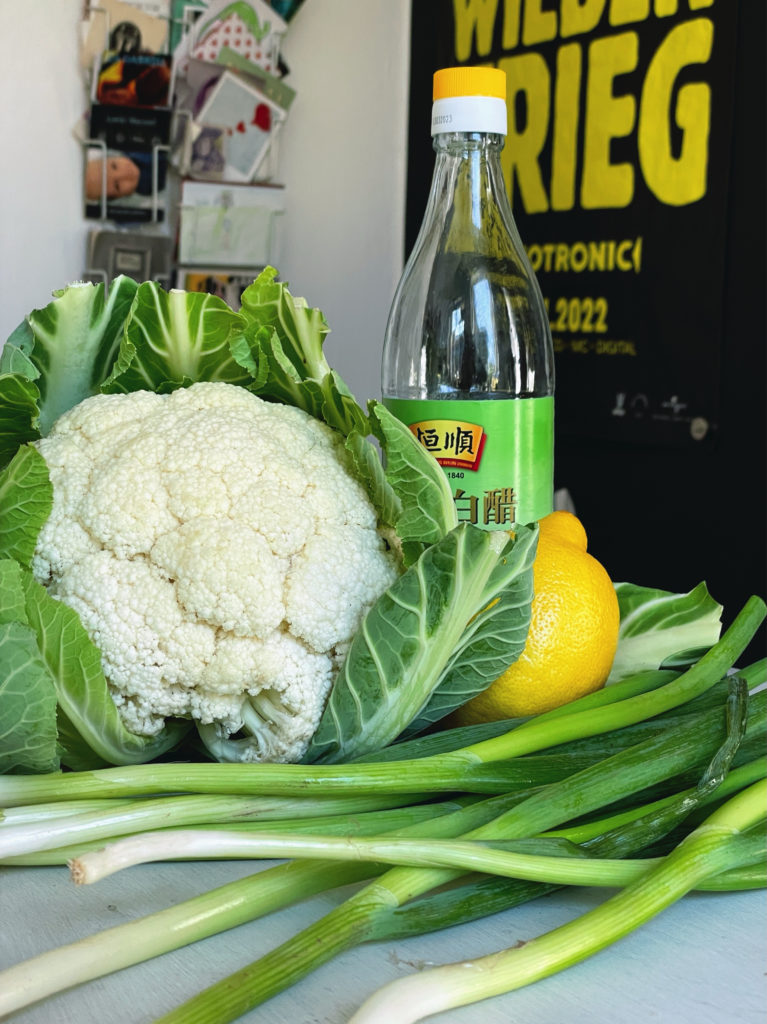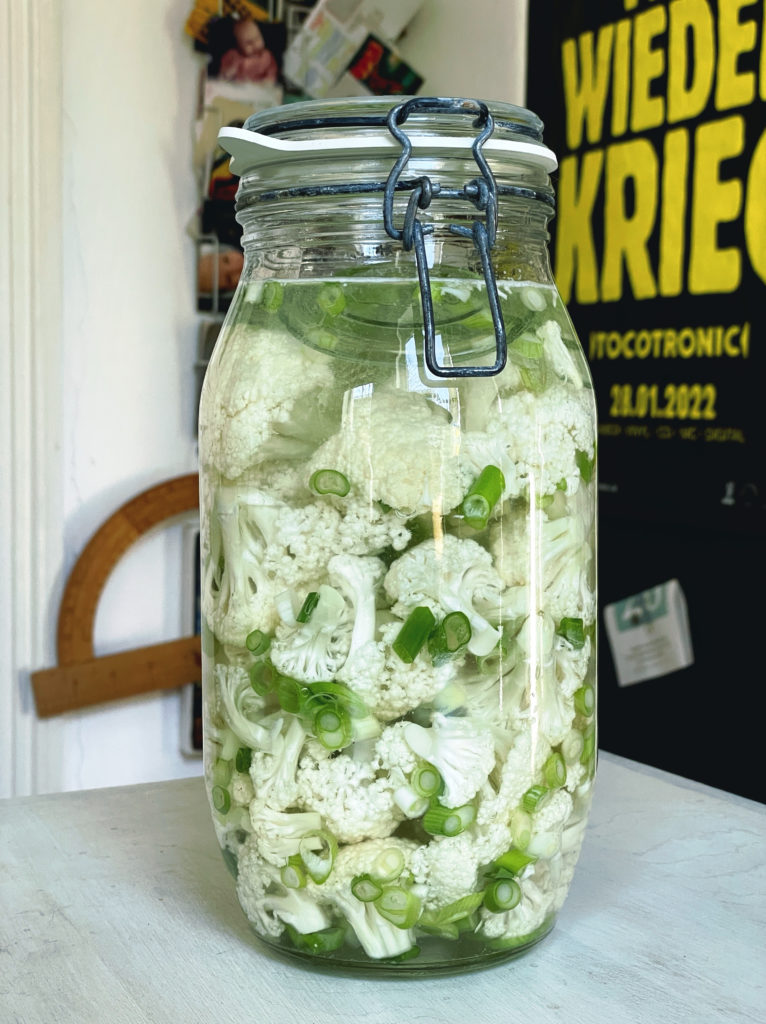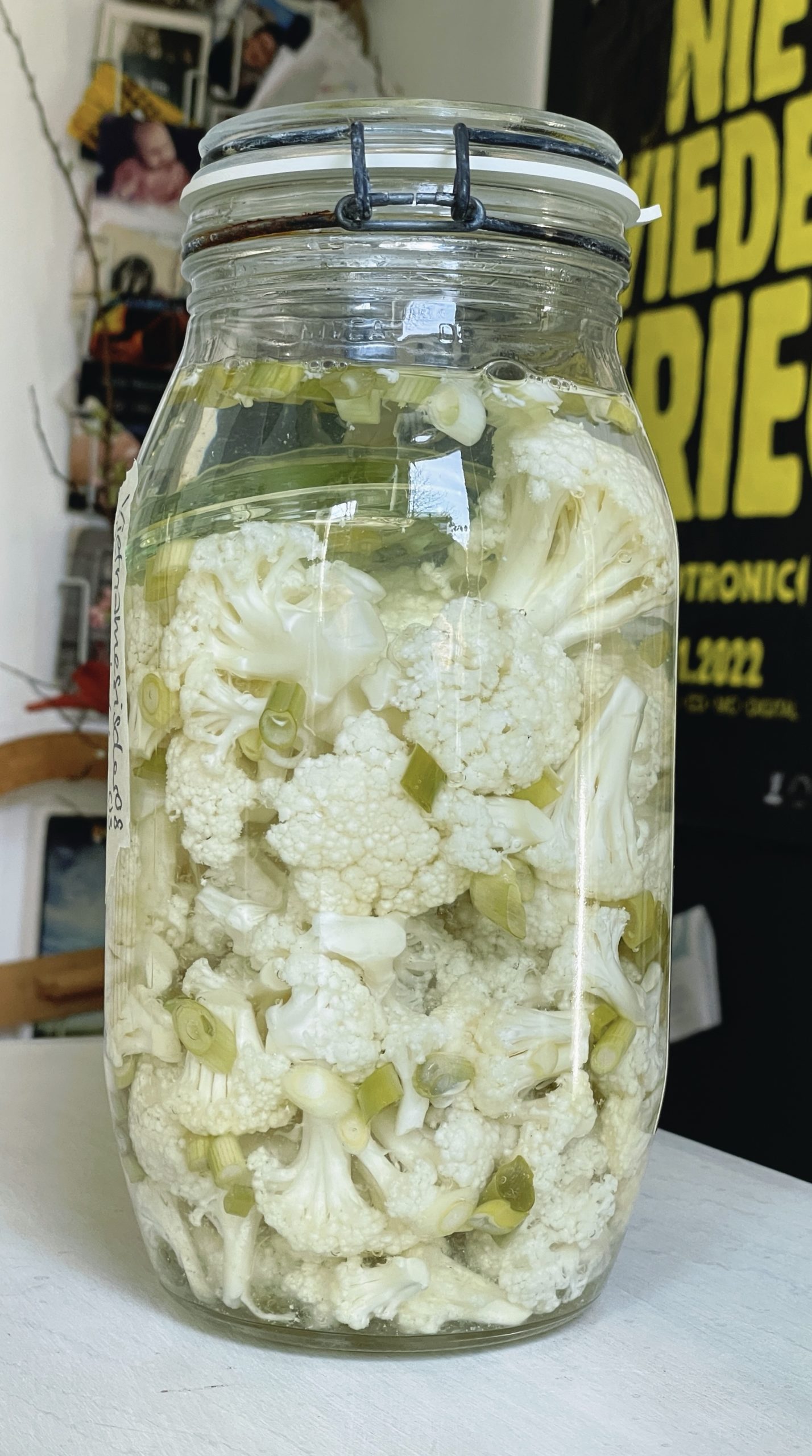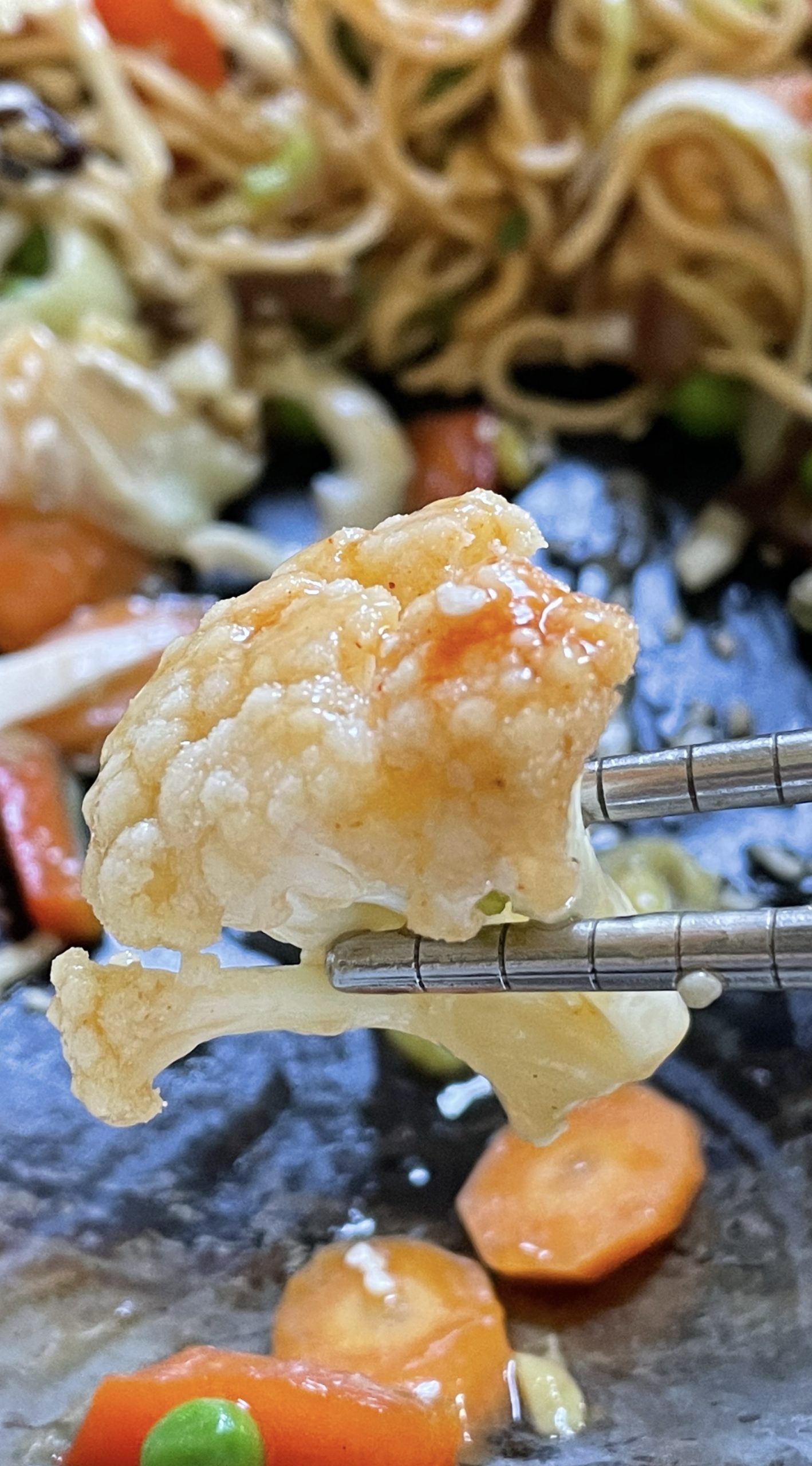I learned this great quick ferment from Hang in the fall of 2021, and I'm honored to share the recipe here and also to spread some knowledge about Vietnamese ferments. Since Vietnamese-style cauliflower is easy to prepare and ready quickly, it's a great beginner's ferment. Plus, it's a tasty bring-along for an impromptu barbecue the following weekend. A really great summer seasonal ferment! Hang calls this dish cauliflower à la Hanoi style.
I got to know Vietnamese cuisine when I lived in Berlin in the 1990s and was in love at first bite. Phở, summer rolls, and bánh mì, I couldn't get enough of it and went feasting in Vietnamese restaurants and snack bars when time and student budget allowed. However, fermented cauliflower was not on my list of dishes at the time, as this crunchy ferment was not offered in restaurants.
Fermentation has a centuries-old tradition in Vietnam, and quick ferments are very popular
There are more than 50 ethnic groups in Vietnam, all of whom have and maintain immense knowledge of fermentation processes. They create unique flavors. Traditionally, wild fermentation is used, meaning that most fermentation processes utilize the microorganisms of the produce or the environment. Nem chua, sour fermented pork, and Đồ Chua, fermented fruits and vegetables, are examples of popular wild ferments intended for quick consumption. And despite the growing industrialization in food production, fermentation is still commonly used for preservation.
Fermented vegetables are very popular in Vietnam. From eggplant to lotus root, everything is fermented.
Hang Quin
For preparation, the vegetables are cleaned, sometimes peeled, dried and then placed in brine* in airtight containers for 1-3 days for fermentation. In addition to vegetables that are also commonly fermented in other countries, such as cabbage, cucumbers, mustard, garlic and onions, in Vietnam people also ferment lotus roots, eggplant, jackfruit, bamboo shoots and raw mangoes. Also, of course, cauliflower.
* 2-7% salt with sometimes up to 3% sugar
INGREDIENTS
- 1 small head of cauliflower
- 1 bunch of scallions
- 1 liter water
- juice of 1 lemon (30 ml)
- 2 tsp rice vinegar (10 ml)
- 20-30 gr. salt
PREPARATION
Cut the cauliflower into bite-sized pieces and the spring onions into rings. I find it quite nice to have variety when eating, so I cut them into small and slightly larger pieces.



Make a brine with water, salt, lemon juice and vinegar. Hang's traditional recipe uses lemon juice for acid, which she substitutes with distilled vinegar only when she doesn't have any lemons. I like the combination of lemon juice and rice vinegar extremely well. But you can decide for yourself what you like and prepare this ferment with the acid of your choice.
The quantity fits into a 1.8l swing-top jar. You can use any other vessel that allows gases to escape without letting oxygen in. The vegetables should be completely under the brine. For this you can use weights, or, like Hang, place a heavy plate on top of the vegetables. Wedged shish kebab sticks also work quite well.
Place at room temperature. After only 3-4 days the cauliflower is ready to serve.
How does fermented cauliflower taste?
Fermented cauliflower after a short fermentation period tastes pleasantly sour, salty and crunchy and overall very harmonious. The aroma of the allium is well perceptible.
The acidification process proceeds very quickly. If you don't like it that sour, chill the container to slow down the fermentation process. The first time you can just leave the jar, or some of the contents sit to find out at what acidity level it tastes best to you. Please take out the fermented food consistently with clean utensils, otherwise it can easily spoil.
How to eat fermented cauliflower?
Like all other vegetable ferments, fermented cauliflower is fabulous as a snack. Pure, dipped in various sauces, such as Nước chấm or sweet soy sauce, I like it nearly best. As a side dish with Banh Mi or as part of a tasty salad, cauliflower also goes down really well. We also like it sliced on sandwiches, and of course as a sour note in all kinds of stir fries.


Is that even fermenting if citric acid or vinegar is used?
If you add just a little acid, lactic acid fermentation still takes place. Many fermentistas even use this technique deliberately, but with the lactic acid brine of a previous ferment. This is called backslopping, the idea being to give the ferment a good bacterial start.
I'm not a fan of backslopping as such, because the bacteria take a shortcut due to the already lactic acidic environment and no longer reliably go through all stages of their life cycle. This can lead to a not so balanced taste. However, it is not dangerous for health.
With some ferments, however, I really appreciate the addition of acid because it changes the flavor profile. Curtido for example tastes very delicious when you add lime juice to the ferment.
If you are interested in the science: Acetic acid bacteria and lactic acid bacteria grow at a pH of about 3-4. If you don't get below that by acidifying, lactofermentation takes place.
Sources
- Hang Quin
- Nguyen La Anh, https://www.sciencedirect.com/science/article/pii/S2213453015000464
- Vu Nguyen Thanh (Food Industries Research Institute), Nguyen Thi Viet Anh, https://www.researchgate.net/publication/305910163_Ethnic_Fermented_Foods_and_Beverages_of_Vietnam
- Spektrum der Wissenschaft, https://www.spektrum.de/lexikon/biologie/acidophile-mikroorganismen

Das klingt gut. Ich habe noch etwas Blumenkohl , den möchte ich so machen. Vielen dank
Gutes Gelingen und guten Appetit!
Freue mich über neue Rezepte
Ich hab das Rezept gerade angesetzt, nur ohne Frühlingszwiebeln, die hatte ich nicht mehr da.
Kann ich das Ferment auch länger stehen lassen, bis zu 5 oder 7 Tage, bevor es in den Mund und Kühlschrank wandert?
Wahrscheinlich ab Tag 4 täglich probieren, wa?
Hej Felix,
klar, kannst Du machen. Dann findest Du auch raus, wann es Dir persönlich am besten schmeckt!
Guten Appetit,
Katsu
Hallo liebe Katsu, könnte man auch den Reisessig ersetzen oder macht diese Art von Essig den Geschmack aus? LG und vielen Dank für das Teilen Deiner Rezepte und Erfahrungen.
Hej Peggy,
genau, wie ich geschrieben habe: “Aber auch hier kannst Du selber entscheiden, was Dir persönlich schmeckt und dieses Ferment mit der Säure Deiner Wahl zubereiten.” Jeder Essig hat Geschmack, und Reisessig ist eher mild. Wenn Dir eine andere Säure besser mundet, nimmst Du die.
Gutes Gelingen!
Katsu
[…] Säure das Geschmacksprofil auf das Köstlichste, so dass ich nicht darauf verzichten würde. Fermentierter Blumenkohl auf Vietnamesische Art nach Hang Quins Rezept schmeckt zum Beispiel am besten, wenn man […]
Hallo,
habe die ersten Röschen “genascht” super lecker. Kann ich ich eigentlich aus TK Blumenkohlröschen nehmen?
Viele Grüße
Hej Matthias,
das geht ein bisschen am Ziel des Fermentierens vorbei, den Überfluss der Saison ohne grossen Energieaufwand haltbar zu machen 😉
Aber theoretisch ja, du könntest das machen. Die Frühlingszwiebeln bringen genug aktive Laktobazillen mit, um die Fermentation zu starten.
Gutes Gelingen!
Katsu
Hallo Katsu,
vielen Dank für die Antwort, ich werde es probieren und dann berichten.
Liebe Grüße
Matthias
Hallo Katsu,
habe es mit den TK Blumenkohlröschen probiert, dabei habe ich aber die Menge der Frühlingszwiebeln verdoppelt und noch zwei Knoblauchzehen zugefügt. Nach 4 Tagen musste ich dann einfach mal probieren😜, war so gespannt. Und was soll ich sagen, es hat super geschmeckt….sooooo lecker. Natürlich bin ich auch für frische Produkte, aber der TK Blumenkohl ist ja eigentlich auch super knackig und schon so schön mundgerecht. Also ich kann diese Variante auch empfehlen.
Liebe Grüße
Matthias
Hej Matthias,
das freut mich, dass es geklappt hat und dir so gut schmeckt!
Weiter viel Spaß beim Fermentieren,
Katsu
interessant !! wenn ich gründlich waschen oder gar schälen muss, gebe ich auch immer alle paar Zenimeter Füllhöhe ein/zwei Gierschblätter mit rein, um Mikroben einzuimpfen. Dass es auch mit so Blanchiertem und dann Gefrorenem funktioniert hätte ich nicht gedacht…DANKE für´s Teilen
Hallo Katsu,
könnte man das Rezept auch mal mit einem TL Honig ausprobieren?
Liebe Grüße
Matthias
Hej Matthias,
klingt spannend, probiere es aus!
Gutes Gelingen,
Katsu
mache heute 3 rezepte nach, unter anderem den blumenkohl. ich weiss nicht, wie du das machst, bei mir treibt einfach alles oben, einschließlich blumenkohlröschen und vor allem aber die frühlingszwiebeln. hier ist es noch schwieriger als zB. beim fenchelrelish, das ganze runterzudrücken, es schiebt sich alles an den deckeln vorbei…aber auf deinem foto sieht man auch viele frühlingszwiebeln oben schwimmen, also ist es wohl nicht so dramatisch? ansonsten bin ich gespannt. der fermentierte kohlrabi aus sri lanka ist übrigens auch einfach nur köstlich
Hej Susann,
wenn die Fermentation schon in Gang ist, ist ein Auftreiben verschmerzbar. Zu Beginn muss alles unter der Lake sein. Schichte die Deckel überlappend und bewege das Glas danach nicht mehr. Einmal geöffnet ist das bei diesem Ferment tatsächlich fast nicht möglich, alles unter der Lake zu halten, drum iss es am besten schnell auf.
Auf dem Photo ersten Photo sind es die Glasdeckel, die grünlich schimmern, und keine Frühlingszwiebeln, auf dem zweiten Photo siehst du an der Trübung, dass die Fermentation schon stattgefunden hat, ich habe dort schon Blumenkohl entnommen.
Gutes Gelingen!
Katsu
hej, also aufgetrieben sind die röschen direkt nach dem ansetzen, habe das glas baldigst in kühlschrank befördert. der blumenkohl schmeckt, aber es kribbelt. auch meine tochter ist sich unsicher, ob es so in ordnung ist. darf es kribbeln oder ist es dann doch irgendwie gekippt?
liebe grüße
Hej Susann,
kribbeln ist gut, das bedeutet, dass CO2 vorhanden ist, was bei der Transformation der Kohlenhydrate durch die Milchsäurebakterien passiert. Wenn etwas auftreibt, kann das Gefäss mehrmals täglich geschwenkt werden, damit die Lake das Gemüse trotzdem benetzt. Eine Temperatur von ca. 19° C ist die ersten Tage wichtig, drum am besten erst nach frühestens 4 oder 5 Tagen kühler stellen.
Bleibt gesund!
Katsu